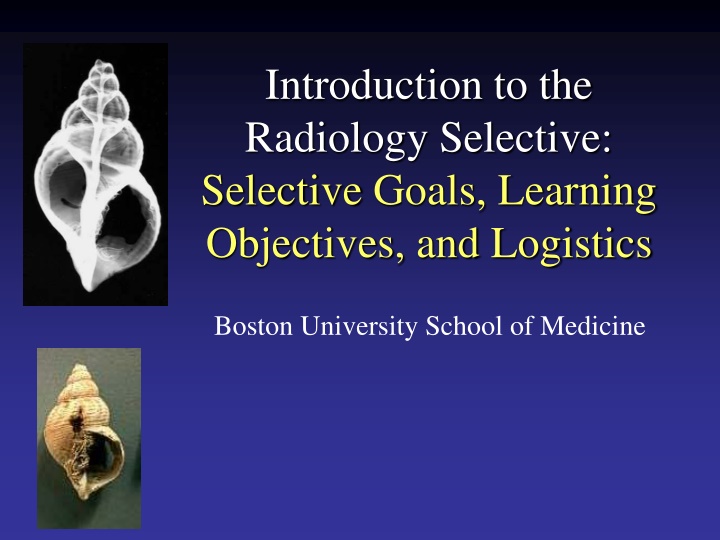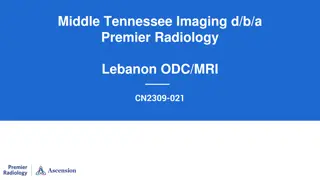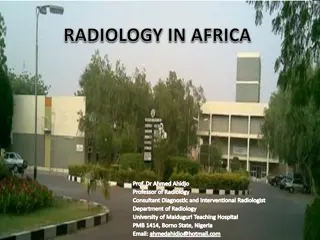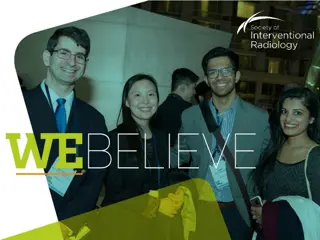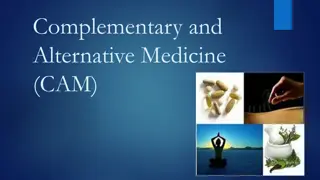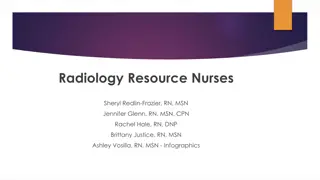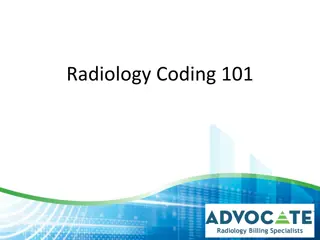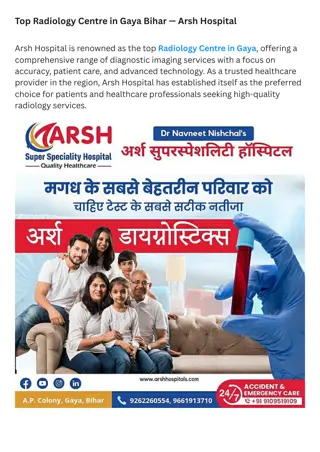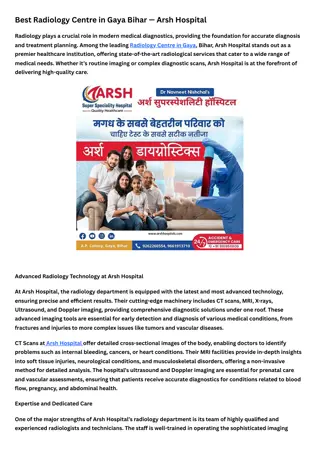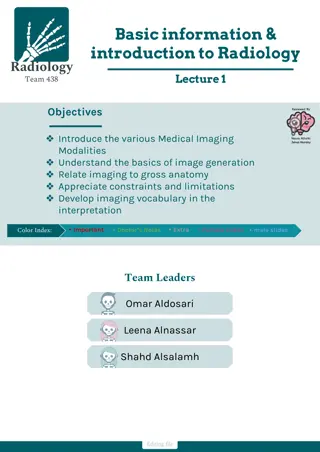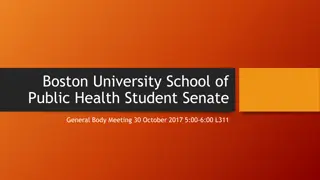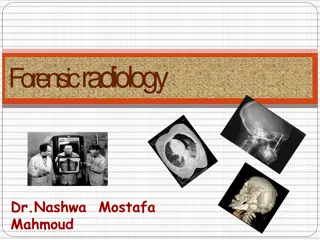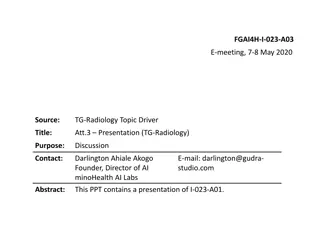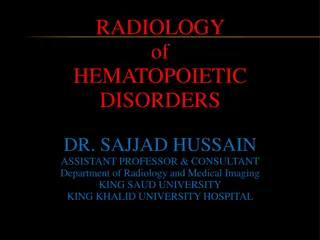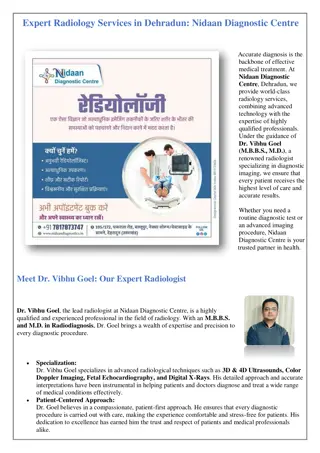Radiology Selective at Boston University School of Medicine
Delve into the goals, learning objectives, and logistics of the Radiology Selective at Boston University School of Medicine in this informative guide. Explore the intricacies of the selective to gain valuable insights and perspectives.
Download Presentation

Please find below an Image/Link to download the presentation.
The content on the website is provided AS IS for your information and personal use only. It may not be sold, licensed, or shared on other websites without obtaining consent from the author.If you encounter any issues during the download, it is possible that the publisher has removed the file from their server.
You are allowed to download the files provided on this website for personal or commercial use, subject to the condition that they are used lawfully. All files are the property of their respective owners.
The content on the website is provided AS IS for your information and personal use only. It may not be sold, licensed, or shared on other websites without obtaining consent from the author.
E N D
Presentation Transcript
Introduction to the Radiology Selective: Selective Goals, Learning Objectives, and Logistics Boston University School of Medicine Sea_Shells
BUSM Institutional Learning Objectives: BU CARES Behaves in a caring, compassionate and sensitive manner toward patients and colleagues of all cultures and backgrounds. (Patient Care and Professionalism) Uses the science of normal and abnormal states of health to prevent disease, to recognize and diagnose illness and to provide an appropriate level of care (Medical Knowledge; Patient Care) Communicates with colleagues and patients to ensure effective interprofessional medical care (Interpersonal and Communication Skills, Patient Care) Acts in accordance with the highest ethical standards of medical practice (Professionalism) Reviews and critically appraises biomedical literature and evidence for the purpose of ongoing improvement of the practice of medicine (Practice-based learning and Improvement, Medical Knowledge) Exhibits commitment and aptitude for life-long learning and continuing improvement as a physician (Practice-based Learning) Supports optimal patient care through identifying and using resources of the health care system (Systems-based Practice; Patient Care)
Radiology Selective Goal Expose students to all aspects of imaging, including a variety of imaging modalities. Provide students with the fundamental knowledge necessary for interpretation of studies and/or radiologic reports as well as an understanding of the principles of evidence-based imaging.
Radiology Selective Learning Objectives 1. Describe the range of available diagnostic imaging examinations including strengths and limitations, and use available tools (ACR Appropriateness Criteria) to select imaging appropriately (including Evidence-Based Imaging session): URS 2. Review appropriate terminology used to describe findings in each modality, to facilitate communication with radiologists, reading and understanding radiology reports, and presenting/discussing cases in various medical settings (including case presentations, daily didactic sessions, OSCEs): UC 3. Describe the basics of what a patient will experience when they have each of these different types of radiology exams, to more effectively explain them to their patients, and realize when a patient is not appropriate for a particular type of exam due to physical limitations, clinical condition, as well as addressing patient fears (including clinical observations): BCA
Radiology Selective Learning Objectives 4. List the costs, risks, preparation, and any follow-up care needed for each of the various types of exams (including Evidence-Based Imaging, Clinical observations, didactic lectures, OSCEs): UCS 5. Differentiate normal anatomy from clinically important abnormal conditions on common studies (including Radiology-Anatomy lab, Cadaver Biopsy, Clinical observations): U 6. Analyze, synthesize and evaluate the medical literature while preparing the Evidence-based Imaging and Radiology-Pathology presentations: URE 7. Act in a professional manner by being punctual, maintaining appropriate demeanor in the Radiology department, being prepared for all assigned activities, and maintaining patient confidentiality at all times (all activities): BAE
During the Radiology Selective Develop a systematic approach to image interpretation Recognize ~30 common and clinically important diagnoses, e.g., intracranial hemorrhage, CHF, pneumothorax, pneumonia, free air, SBO, and fractures.
Selective Logistics Daily schedule: 8:00-9:30am: Didactic session with radiology resident 9:30-12:00pm: Clinical observation via Zoom Readouts, Online Lecture Review, Reading, Review, Presentation Preparation. 12:00-1:30pm: Back to Back Radiology Noon Conferences You will be forwarded a weekly schedule of the Noon conferences Educational, Resident, and Case Conferences 1:30-5:00pm: Didactic session with radiology attending, Zoom Readouts, Multidisciplinary Conferences
Self-Directed Learning Basic Principles of Diagnostic Radiology powerpoint presentation on blackboard under Core Lectures and Required Diagnoses Folder Websites: www.learningradiology.com http://eradiology.bidmc.harvard.edu/ -Lieberman's lectures http://radiologymasterclass.co.uk/ - Chest and Abdomen https://radiopaedia.org/
Medical Student Presentations Evidence-Based Imaging (Pass/Fail) Additional afternoon sessions/activities (Pass/Fail) Radiology-Anatomy Lab
Quizzes Given once a week (on Friday), 3 quizzes total. On the fourth Friday of the rotation is the final exam. 20-30 short-answer (not multiple choice) questions per quiz, geared toward identifying normal structures/abnormalities/disease processes on the topics discussed in the morning core lectures. Week 1 Chest quiz, Week 2 Abdomen quiz, Week 3 MSK/Pedi quiz Answers will not be revealed/reviewed per BUSM policy. Preparation: Attend and review daily conferences Supplementary reading
Radiology Selective Objective Structured Clinical Exam (OSCE) At the end of each week, you will have an OSCE case (an image) containing a short clinical scenario followed by 5 open ended questions. 5 questions correspond to the different sections of a radiology report. History Imaging findings Impression/differential diagnosis Next step in care/additional imaging recommendations Follow-up question pertinent to the case Graded using a standardized grading sheet.
Radiology Selective Evaluation Graded components (92% total) Final examination, 30% Three quizzes, 10% each, for a total of 30% OSCEs 4 total (4 week block), 8% each, 32% in aggregate Pass/Fail components (4% total) Evidence-Based Imaging presentation, 4% Radiology-Anatomy Lab, 4%
Radiology Selective Evaluation Complete 8 Who Did You Work With evaluations through E*Value; on 4 attendings/4 residents that you worked with throughout the block. We will not release your final grade until all of these are completed. *Medical School Policy On the last day of the Selective, please return the following from your orientation packet to the radiology coordinator, along with the textbooks: Radiology Technologist Shadowing Checklist Technologist Shadowing Questions Clinical Observation Feedback Form completed/signed by attendings/residents 5-7 pm Call Sheet completed/signed Student Time Logged into E*Value - completed Mid-Rotation Selective feedback at beginning of 3rd week No exit interview Final grades will be determined based on attendance,participation, and performance (please see Radiology Selective syllabus on Blackboard for further details) Unexcused absence from a mandatory lecture -2.5% of final grade
Final Examination Web-based 80 multiple choice question examination administered in the computer lab of the Alumni Medical Library focusing on: Basic Imaging Principles Image Interpretation Imaging Strategies Time Limit: 1 hour and 40 min Some questions pertain to images that are provided Image contrast cannot be adjusted, however, this is not needed 30% of Selective grade
BUSM Work Hours On-site hours must be limited to 80 hours per week, averaged over a two-week period, inclusive of all in-house call activities. Students must be provided with one day in seven free from all educational and clinical responsibilities, averaged over a two-week period. One day is defined as one continuous 24-hour period free from all clinical, educational, and administrative activities. Any violation of the work hours policy should be reported by students. Such violations might be created during course, selective, or elective rotations, by attending physicians, residents, or other course or hospital staff members. Students can report concerns about work hours directly to the course or selective director or to an Associate Dean (Academic Affairs, or Student Affairs). If the violation is not rectified, students must report the concern to an Associate Dean who will address the issue with the course or selective director, who will then investigate and report back in writing to the Associate Dean as to how the situation has been rectified. In addition, course and selective specific evaluation forms requested by the Office of Medical Education will have a question regarding adherence to work hours policy. Students who report work hours violations via this method remain anonymous, but the evaluation results are reviewed by the Director of the Office of Medical Education and course directors. This allows course leaders to rectify any violations in their course or selective.
